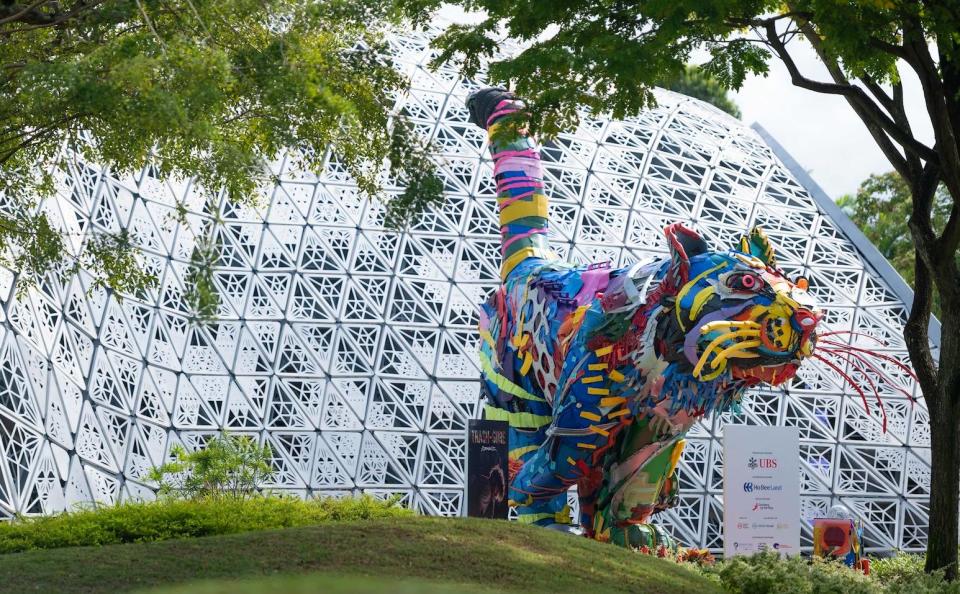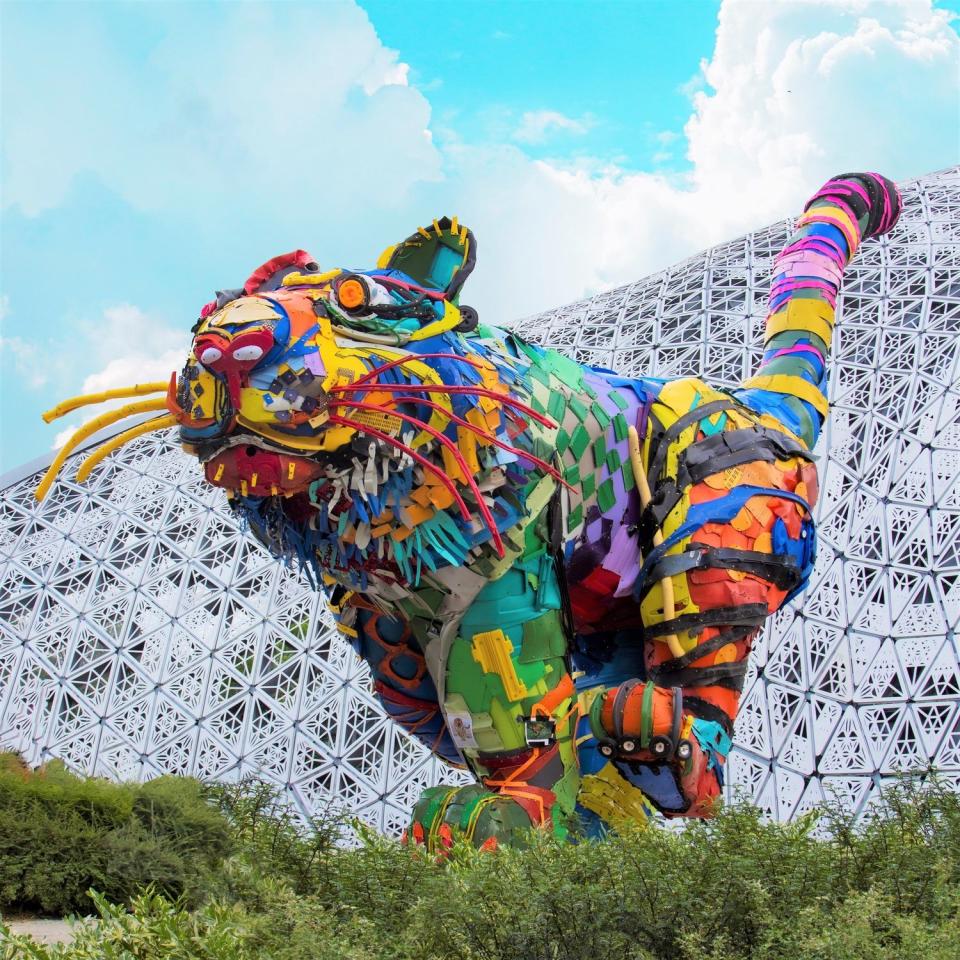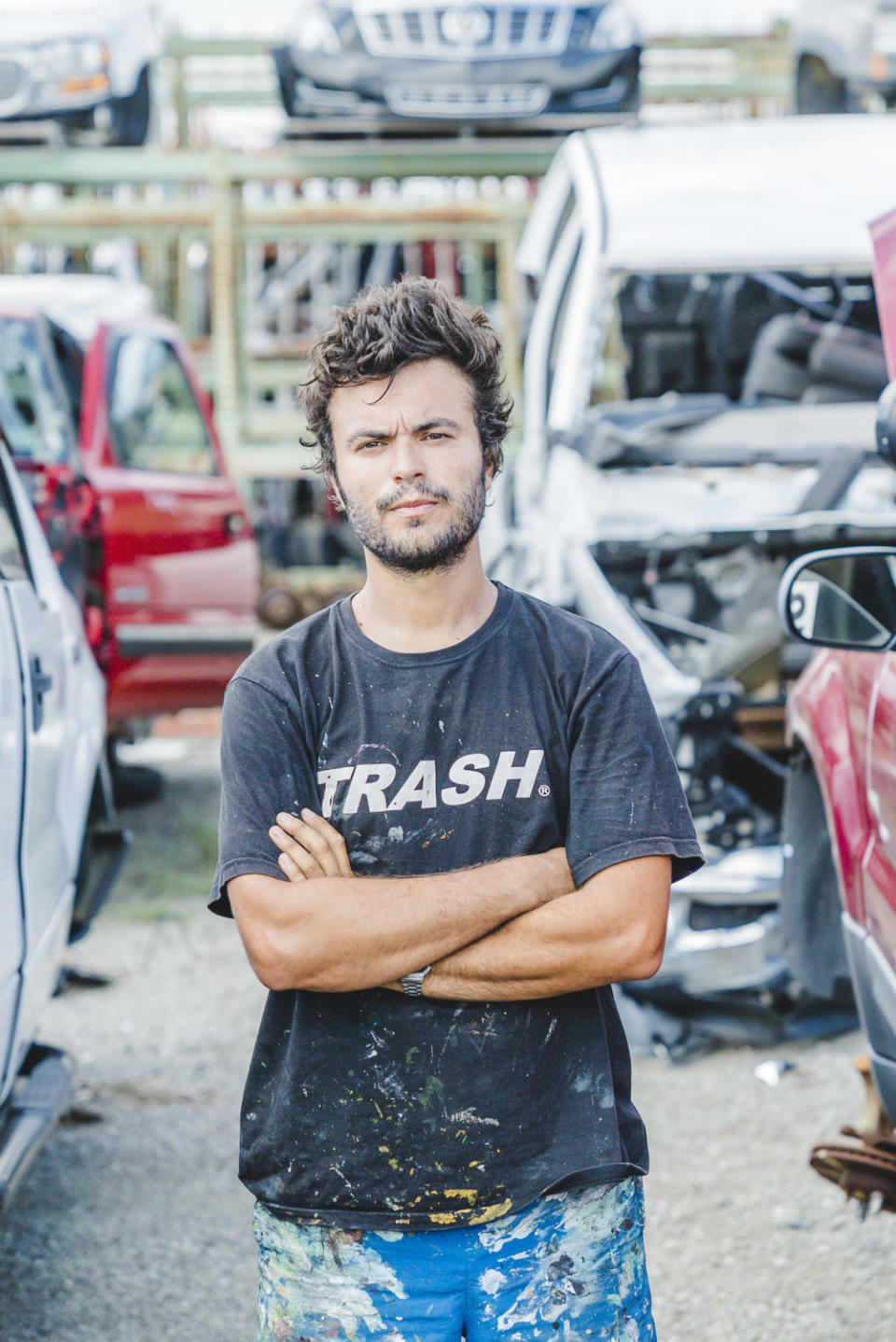UBS shows how trash can turn into meaningful art in its latest Trash-Sure campaign

Multinational investment bank UBS shows how trash can turn into meaningful art in its latest Trash-Sure campaign
Today, two billion tons of trash is being discarded globally every year, contributing rapidly to carbon emissions and global warming. In Singapore, solid waste disposed of over the last 50 years has increased seven-fold. At our current rate of waste generation, our first and only offshore landfill — Semakau Landfill — is expected to be fully filled by 2035.
To reinforce this message and support the Singapore Green Plan 2030, Swiss multinational bank UBS has launched Trash-Sure (pronounced treasure), a campaign that uses art to narrate sustainability, while underscoring the global climate crisis issue.

Teaming up with enterprise partner Ho Bee Land, UBS invited world-renowned Portuguese street artist Bordalo II to build his largest installation in Asia — a 10m by 7m sculpture of the critically endangered Sumatran Tiger — made entirely out of trash. The sculpture takes prime position at the SG50 lattice of Gardens by the Bay and will remain a key attraction there for the next three years as a reminder of conservation and biodiversity, and for each of us to play a part in a more sustainable future.
The trash collected by UBS employees — Ho Bee Land’s construction partner and creative agency Adplanet Group — include end of life materials such as plastic hoses, car fenders, roofs, doors, tires, aircon vents, road dividers, traffic cones, huge water containers, trash bins, portable loos, plastic trays, luggage, trolleys, toys and parts of children’s playgrounds.
In addition to championing sustainability through art, UBS has seen a rise in its sustainability focus and impact investments by 78%, reaching US$251 billion ($346 billion) by the end of last year.
In an interview with Options, Valerie Lau, head of sustainable finance for UBS Southeast Asia and Asia Pacific, talks about the bank’s long-time focus on sustainability and its artistic contributions.
What are UBS key areas of focus when it comes to sustainability?
Sustainability is at the core of our firm’s purpose in three focus areas: People, planet and partnership. At UBS, we reimagine the power of people and capital, to create a better world for everyone.
Our purpose guides us in everything we do. We call this our global ecosystem for investing — where people and ideas are connected. We know finance has a powerful influence on the world. That is why we partner our clients to help them mobilise their capital toward a more sustainable world.
We want to be the financial provider of choice for clients who wish to mobilise capital towards the achievement of the United Nations 17 Sustainable Development Goals (UN SDG #17) and the orderly transition to a low-carbon economy.
Can you briefly talk about the company’s journey in finance sustainability?
We launched our socially responsible investment funds in the 1990s. And for over two decades, we have been focusing on providing clients with the advice, products and solutions they need to achieve their goals as the world moves towards a low-carbon future.
At UBS, we work closely with our clients globally on this sustainability agenda and have seen a rise in our sustainability focus and impact investments by 78%, reaching US$251 billion at the end of last year. This is a trend that is reflected in the Asia Pacific region as well. Our flagship sustainable multi-asset portfolios have seen staggering growth to US$5.4 billion (+102% last year) and with almost one in five clients invested.
At UBS, we adhere to industry best practice and regulatory standards of definition for our sustainable and impact investment product offering. Sustainability-focussed investments must have specific sustainability intentions that drive the strategy, while impact investing goes beyond investment selection, to deliver impact attributable to investor contribution. Impact investments must have explicit intention to generate measurable, verifiable positive sustainability outcomes.
For impact investing specifically, UBS Global Wealth Management (GWM) has directed US$11.6 billion in client assets towards SDG-related investments, far surpassing our commitment of US$5 billion — which was already a sector-leading goal. Our impact investing product offering consists of best-in-class funds, such as the Generation suite of impact funds.
Our UBS oncology impact fund which was very well received in the Asia Pacific region. Globally, our clients have invested US$650 million in MPM Capital’s Oncology Impact Fund 2 (OIF 2), of which US$250 million from Asia. This is an impact investing initiative that invests in private and public companies developing innovative treatments for cancer.
Tell us about your efforts to promote sustainability through art.
UBS has been using art to narrate sustainability over the years. More recently in 2019, as part of a trash-to-treasure campaign, we unveiled Singapore’s tallest upcycled festive tree featuring 6,000 flowers made from discarded bottles. In 2021, our second installation Taking Flight commemorated UBS’s 50th anniversary in Singapore, with 3,500 butterflies and birds crafted from repurposed plastic bottles through the help of community partners.
How did the collaboration with Bordalo II come about?
Over the years, Singapore's growing population and booming economy have contributed to about a seven-fold increase in the amount of solid waste disposed of from 1970 to 2021. At our current rate of waste generation, our first and only offshore landfill — Semakau Landfill — is expected to be fully filled by 2035.
Land is scarce in Singapore, which is why recycling is so important. Being able to innovatively manage waste would make a huge difference to our environment. That’s why we chose to work with world-renowned street artist Bordalo II — a champion in the art of recycling and upcycling — turning trash to treasure.
For this project, he recreated the form of a Sumatran Tiger by repurposing used materials, to also remind us of the importance of conservation. It is set to be one of the largest art installations in Asia made entirely out of trash, and will remain a key attraction here for the next three years.
Aligned to our UBS purpose to connect people for a better world, we hope that this iconic art piece inspires impactful conversations around sustainability.
In the later part of this year, there will also be an art competition titled ‘Art of Trash’, where students in Singapore can enter by upcycling waste materials to create sculptures.

Who is Bordalo II ?
A world renowned ‘artivist’ from Portugal, Artur Bordalo (also known as Bordalo II, pictured) creates stunning three-dimensional sculptures out of debris. Bordalo studied painting at the Academy of Fine Arts in Lisbon for eight years where he discovered sculpture, ceramics and experimented with a variety of materials. Larger than life, his masterpieces serve to remind us that there is too much wastage because of our excessive lifestyles.
His art also powerfully communicates that trash can be reused and recycled.
As street art, the installations of Bordalo II (pronounced Bordalo Segundo) also raise the alarm on our wasteful habits out in public to tackle issues on pollution and its effects on wildlife.
To date, he has built more than 240 art installations in over 20 countries.
See Also:
Click here to stay updated with the Latest Business & Investment News in Singapore
Get in-depth insights from our expert contributors, and dive into financial and economic trends

 Yahoo Finance
Yahoo Finance 